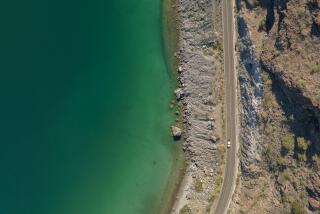They Have No Javelinas : Little “Pigs” Prove to Be Elusive on a Two-Day Hunt in Arizona
- Share via
PHOENIX — The four-wheel-drive vehicle has left the security of Interstate 17 for the muddy ruts of the Tonto National Forest, and the hunters have nervously forded the swollen Agua Fria River, where a rancher’s cardboard sign warns that it costs “$100 to get towed out.”
Now, with the sun rising over Hutch Mesa, driver Dave Daughtry says: “This looks like it ought to be the javelina locker room. If we don’t find something here, I’ll be surprised.”
Daughtry’s confidence is encouraging. It’s the last weekend of the archery season for javelina (pronounced hah-vuh-LEE-nuh). Daughtry, the Arizona Game and Fish Department’s assistant director for information and education, has brought his son-in-law, Rod Klamerus, out for one final chance. Rob Young, the state’s anti-poaching Operation Game Thief coordinator, is also along to lend expertise.
Daughtry and Young are veteran javelina hunters. Klamerus, outfitted in camouflage clothing with a camouflaged compound bow, has never even seen one. But Daughtry likes the lay of the land: “Big, grassy slopes with a scattering of prickly pear (cactus) . . . a spattering of trees in the (ravine) bottom which provide a little shelter, as well as a few rock outcroppings which provide a little overhead relief . . . water in the stock tank, probably water in the potholes, washes and waterways--basically everything a javelina needs.”
Javelina jeaven.
On the edge of the Sonoran Desert, Daughtry stops on a crest and everybody gets out binoculars and “long eyes”--spotting scopes clamped onto the side windows. Hunters call this “glassing.” They are looking for the dark, scruffy little pig-like creatures that inhabit desert regions of the southwestern states, except California.
In the hunters’ vernacular they are “pigs” but, technically, pigs belong to the Suidae family, whereas javelina are peccary of the Tayussuidai family. Their scientific name is Pecari tajacu sonoriensis. They also are known as collared peccary, because of the white streak around their stubby necks. Anyway, “pigs” is easier.
In his painstaking treatise “Javelina in Arizona” compiled in the 1950s and 1960s, biologist Theodore Knipe wrote, “This animal, though a hog, is an unusually attractive looking beast.”
Knipe gave the beast the best of it. When it comes to cuddly, the javelina is no koala. It has bristles instead of fur and it doesn’t say “oink.” Instead, it clicks its teeth and makes guttural noises or a low-key “whoof” when alarmed. Nevertheless, it is Arizona’s second-most popular big-game animal, behind deer and slightly ahead of elk, and a challenge for bow and rifle hunters alike.
“You don’t want to slam doors here,” Daughtry says, whispering.
Javelina can’t see much past their snouts, but their hearing is normal and their sense of smell acute. Their weakness is that they tend to hang out together in herds of about 30, so if you find one you’re likely to have a bunch of javelina on your hands.
*
Finding one is the problem, as Klamerus discovers. They run about the size of a family dog and don’t move around a lot, seldom venturing beyond a home range of one square mile all their lives, studies say. They don’t really try to hide, but they are so low to the ground that their brushy habitat gives them natural cover.
“There might be a dozen behind a clump of prickly pear,” said Daughtry, who has taken a couple of dozen with a bow. “I’ve found them when I saw the prickly pear move.”
Prickly pear--the flat, succulent cactus--is a javelina’s favorite dish. So hunters figure where there’s prickly pear, javelina must be in the neighborhood.
“They’re a lot like humans,” Young says. “They don’t like to be hot or cold. They’ll be out today.”
The scopes pick up five deer grazing on a slope half a mile away. The only sounds are birds singing and coyotes coming off the night shift. Several coveys of quail are flushed and some bright-red cardinals are spotted.
“And you thought we stole the name (of the pro football team) from St. Louis,” Young says.
But the only hint of javelina are some tracks around a prickly pear that aren’t very fresh. Young climbs atop the truck and blows on a device that sounds like rats being strangled.
“They will respond to a varmint call,” Young says. “I’ve called them in to where they’re rubbing against my legs.”
Apparently, on this day the javelina prefer another tune. The hunting party will trek miles through lava rock and catclaw brush until the the backs of their hands look as if they’ve been arm-wrestling bobcats. They hop creeks and slide down hills.
“With javelina, if you’re not wearing out the bottoms of your jeans, you’re not hunting them right,” Daughtry says.
Bowmen fare as well as rifle hunters with comparable success rates of 20-25%. Even a rifleman must get to within about 10 yards of a javelina to get a clear shot, and state regulations encourage using bows, handguns and muzzleloaders by designating special seasons and limiting permits for hunting with rifles. As a result, 37% of javelina hunting is by archery, 31% by rifles, 28% pistols and 4% muzzleloaders.
“That’s why I thought he’d be fun,” Daughtry says, nodding toward his son-in-law. “Usually, the first time a bowhunter hunts javelina, he shoots a lot of (wasted) arrows. Ten yards is a long shot.”
The largest myth about javelina is their ferocity. They aren’t wild boar. They don’t attack poisonous snakes. They won’t attack people--not on purpose, anyway.
Knipe, who studied them for 20 years, wrote: “ . . . the words ferocious and vicious are not applicable. . . . The only person known (to be) injured by javelina was the caretaker at Tovrea’s zoo in Phoenix in 1943.”
Daughtry said: “When you think they’re charging, they just might be trying to get away and don’t know you’re there, their eyes are so bad.”
But with their sharp tusks, it’s wise to get out of the way. Young once jumped onto the top of his car.
Daughtry enjoys more than the hunt. He says the javelina are good to eat.
“I just absolutely love them,” Daughtry said. “I’ll bone them out and make a barbecue or a green chili. They do tend to have a little stronger taste, but you can eliminate much of that if they’re properly cared for in the field.
“As soon as you get one, skin him right on the spot. . . . For a while, the old wives’ tale was that you had to cut that musk gland off. If you skin it, it comes off and you don’t have to get anywhere near it, so you don’t taint the meat.
“You can cut them up in small pieces, put them in a great big crock pot, put in two cups of water and cook them for about 12 hours on low. . . . The last one, my family wouldn’t even let me put barbecue sauce on it. It was as good as a good pork loin. It has that kind of texture.”
*
The hunters meet a cowboy, Clay Logan from the Horseshoe Ranch, who is out looking for a wayward calf. When they stop later to look from a hilltop, Logan rides up again and says, “I found you some (javelina).”
He has spotted a single javelina about a mile away down in the canyon and Daughtry picks it up with a scope before it disappears into the brush. He decides it would be too difficult to pursue, so they go on.
“Finding one javelina is really tough,” Daughtry says. “He knows he doesn’t have the rest of the herd to rely on.”
In midafternoon they find some tracks, so they spread out and sweep all the way around a hill but find nothing.
“They’re hard to find, but never this hard,” Daughtry says. “I don’t think Rob (Young) and I have ever been out together when we failed to find them.”
The day ends on that note, but the hunters are back out before first light the next day, trying various areas.
In the last one, Daughtry works his way up one side of a long draw with Klamerus on the other side. At the top, Daughtry looks back down and sees Klamerus standing motionless, with an arrow notched. Klamerus slowly raises one hand to point to his eyes, then into the brush in the gully in front of him.
Klamerus holds his position for nearly an hour as Daughtry circles around to the opposite side, hoping to flush the javelina toward his son-in-law. Nothing.
Afterward, Klamerus says: “I saw him through the bushes. I couldn’t see his whole body, (just) his hair moving.”
Daughtry figures the javelina slipped out down the draw.
“How smart are they?” Klamerus asks.
Apparently, smarter than they look. On these two days, Daughtry will learn later, no other hunter he talked to found any javelina. The next day is the Super Bowl, but the javelina score is already in.
“Pigs 2, Hunters 0,” Daughtry says.
More to Read
Sign up for Essential California
The most important California stories and recommendations in your inbox every morning.
You may occasionally receive promotional content from the Los Angeles Times.













